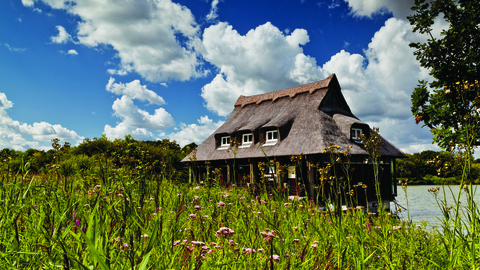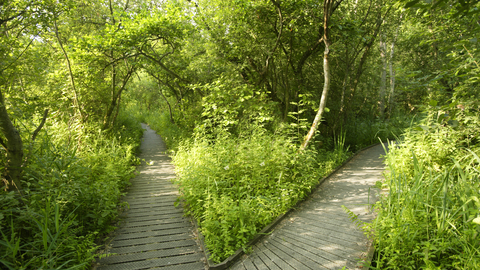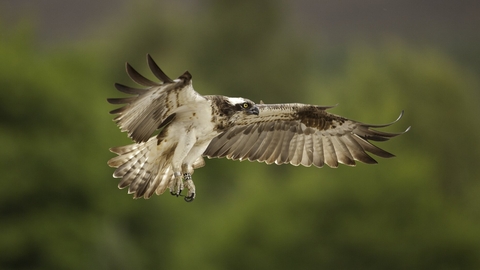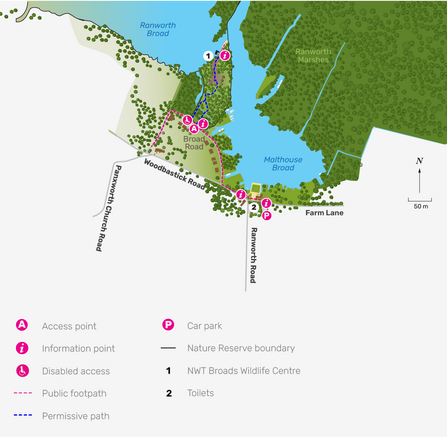
Ranworth Broad Visitor Centre (credit: Tom Mackie)

Ranworth Broad (credit: Matt Wickens)

Boardwalk at Ranworth (credit: Richard Osbourne)

Osprey in flight (credit: Peter Cairns/2020VISION)
Ranworth Broad and Marshes
Location
By train/bike: the reserve is a 25 minute cycle ride from Salhouse and Acle stations which have regular train services to Norwich, Great Yarmouth and Sheringham. Cycles can be taken on trains on both lines, although booking is recommended.
If travelling by bus, please check times and routes online as they change frequently.
OS Map Reference
TG 360 146View on What3Words
Know before you go
Dogs
No dogs permitted on reserve or in visitor centre apart from assistance dogs.
When to visit
Opening times
Reserve: Dawn till dusk, every day, all year round.Visitor centre:
1 April – 27 October: 10am-5pm
28 October – 3 November: 10am-4pm
Best time to visit
All year roundAbout the reserve
A magnificent, ancient oak stands sentinel at the start of the boardwalk. This accessible wooden pathway ambles through wet carr woodland before opening into reed fen. At the trail’s end sits our small, floating visitor centre with its thatched roof. Inside you’ll find interactive displays, a gift shop, and fantastic vistas across Ranworth Broad.
This short walk allows the experience of being deep in a reedbed, with reed warbler and Cetti’s warbler nesting close to the boardwalk. It is also excellent for seeing close-hand many of the unusual and interesting plants that grow in Broadland habitats. Royal fern, decades-old tussock sedges, orchids, and six-foot-tall marsh sowthistle are found here, and many other fenland plants.
The picnic benches outside the visitor centre are a fantastic place to sit any time of the year. Spend an early spring morning listening to the dawn chorus or seeing common tern returning after their arduous migration back from Africa. Multiple pairs nest on the special rafts provided in front of the visitor centre. Sit for a while and watch their noisy antics as they acrobatically plunge into the water to catch small fish.
In summer, it is one of the best places in the Broads to spot the rare swallowtail butterfly and Norfolk hawker dragonfly. A pair of ospreys – the majestic fish-eating bird of prey – have been known to spend the summer at Ranworth Broad, and we hope they will breed here one day.
In winter, you can watch large gatherings of wildfowl from our raised platform, and hundreds of cormorants roost in the skeletal dead trees at the end of the broad. Many thousands of gulls roost on the broad, and at twilight they fall like snow, making a magnificent winter spectacle. Marsh harriers are present all year, and it is not uncommon to see a family of otters playing together along the edge of the Broad.
A new hide on Decoy Dyke is already proving popular for sightings of kingfisher zipping across the water. Great crested grebes, paired in their elegant summer plumage, can often be seen imitating one another in their elaborate courtship dance. Later in the summer, look out for their humbug-striped chicks catching a piggy-back from their parents.
Much of the reserve is inaccessible on foot, so one of the best ways to enjoy Ranworth is by joining one of NWT’s watertrail boat trips. Various itineraries run from April to October, exploring Ranworth Broad and the River Bure.
Species
Habitat
Contact us
Environmental designation

Seasonal highlights
Spring
Birds: common tern.
Plants: early marsh orchid, marsh marigold.
Summer
Birds: osprey.
Invertebrates: swallowtail butterfly, Norfolk hawker dragonfly.
Plants: common twayblade.
Autumn
Birds: siskin, lesser redpoll.
Plants: tussock sedge.
Winter
Birds: wildfowl, Cetti’s warbler, marsh harrier.
